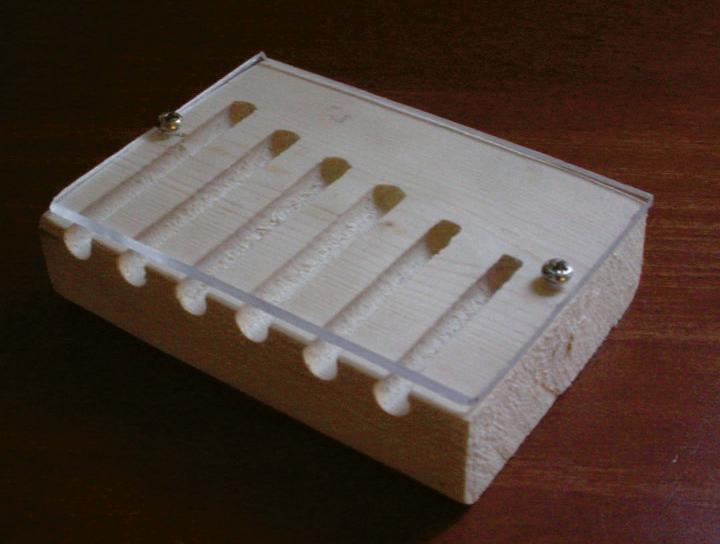
While the alfalfa leafcutter and blue orchard bees have been the focus of much attention, numerous other cavity-nesting bees have management potential. Most of these bees lack common names and are not well studied, but their nesting requirements are largely understood.
A simple way to isolate these wild bees and select new species for future management is through the use of observation nests. Such nests typically consist of a grooved nest board (with a series of dead-end tunnels routered along one side), which is then covered with a tight-fitting transparent cover (Figure 9.2). Since light infiltration discourages cavity-nesting bees, the transparent cover should be shielded by some sort of opaque material that can be easily removed.
Ideally these types of observation hives should have a variety of hole sizes and depths, and they should be placed in areas where cavity-nesting bees are likely to be found: near old wooden barns, fallen trees, or brush piles, for example. The nests can be monitored for activity by periodically removing the opaque covering and examining the nest interior though the transparent cover. The type of food provision and cell partition present can then be used to identify most bees down to the family and genus level—even during immature stages (Table 9.1). Note that when the food provision consists of other insects such as grasshoppers or spiders it means the cavity is not occupied by an immature bee, but rather by a predatory wasp.
Table 9.1 Identifying Cavity-Nesting Bees by Nest Construction
| Cell Partition Material | Adult Color Pattern | Family | Genera | Common Name |
| Mud, chewed paint material | Metallic, solid black, occasionally other | Megachilidae | Osmia, Hoplitis | Mason bees |
| Plant resins, sand, pebbles | Striped | Megachilidae | Chelostomoides | Resin bees |
| Cut or chewed leaf sections | Striped | Megachilidae | Megachile | Leafcutter bees |
| Compacted fibers, or hair, resins and sand | Black and yellow or black and white | Megachilidae | Anthidium | Carder bees |
| Compacted sawdust | Various colors | Apidae | Xylocopa, Centris | Carpenter bees |
| Plastic-like membrane | Various colors | Colletidae | Hylaeus | Masked bees |
Table note: When the food provision consists of other insects, the cavity is occupied by a predatory wasp, not a bee.
After checking the contents of the observation nest, it should be placed back in its original position. Painting the fronts of the nests different colors will help reduce disorientation by returning foragers.
The majority of cavity-nesting bees belong to the Megachilidae family. Among these are many species that seal off their cell partitions with strong, gluelike plant resins. While these bees are interesting to observe, they present unique management challenges, and would probably require some sort of disposable nesting system (such as a drilled block with paper inserts) for active management.
